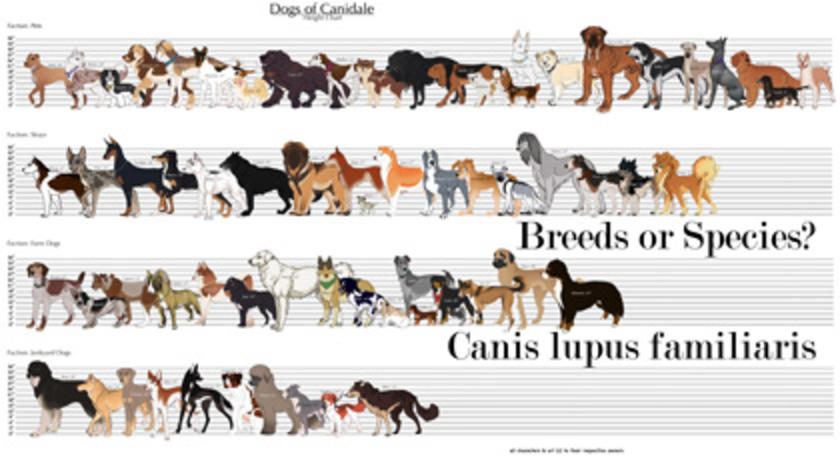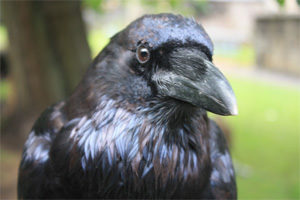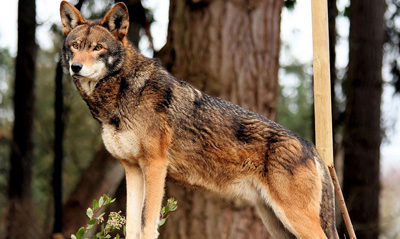"We argue that extinction by speciation reversal may be more widespread than currently appreciated. Preventing such extinctions will require that conservation efforts not only target existing species but identify and protect the ecological and evolutionary processes that generate and maintain species".Another paper worries that climate change is hastening the loss of landscape heterogeneity thus encouraging "Interspecific hybridization [which] is .... an evolutionary process that is (i) highly susceptible to human influences, and (ii) very fast" and that "The most probable proximate outcome of such hybridization will be a collapse of hybridizing species and subsequent loss of biodiversity."
A third paper laments the speciation reversal seen in two previously separately identified raven species in California, the non-sister lineages of 'California' and 'Holarctic' ravens, which underwent a fusion and formed the Common Raven. This "represents a case of ancient speciation reversal that occurred without anthropogenic causes." This same paper holds that "Under certain circumstances, hybridisation can cause distinct lineages to collapse into a single lineage with an admixed mosaic genome. Most known cases of such 'speciation reversal' or 'lineage fusion' involve recently diverged lineages and anthropogenic perturbation."
What in Darwin's Name is going on here? Whole species going extinct by speciation reversal - an existential threat to biological diversity on Earth? Or just a threat to the concepts of modern biology?
The biological concepts are: "Speciation is the evolutionary process by which populations evolve to become distinct species." However, "introgressive hybridization erodes differentiation until species collapse into a hybrid swarm. A special case of introgressive hybridization is speciation reversal, in which changes in selection regimes increase gene flow between sympatric species, thus eroding genetic and ecological differences. Speciation reversal may be particularly important in adaptive radiations with recently diverged sympatric species that lack strong intrinsic postzygotic isolation." [quote link]
Let's see if we can sort some of the terms out: [in all senses here, we are talking of natural interactions in the biota and we will exclude any consideration of the possibilities of human directed genetic manipulation such as CRISPR-Cas9 techniques.]
Introgressive hybridization, in genetics is the movement of a gene (gene flow) from one species into the gene pool of another by the repeated backcrossing of an interspecific hybrid with one of its parent species. Purposeful introgression is a long-term process; it may take many hybrid generations before the backcrossing occurs.
Interspecific hybrids are bred by mating individuals from two species, normally from within the same genus. The offspring display traits and characteristics of both parents. [Many interspecific hybrids are sterile, preventing gene flow between the species. An example is the mule, a sterile cross between donkeys and horses.]
Sympatric species are species that occupy the same or overlapping territories - sympatric and sympatry are terms referring to organisms whose ranges overlap or are even identical.
Species: Oh boy - we have a problem here. Let's try the old high school standard: "A species is often defined as the largest group of organisms in which two individuals can produce fertile offspring, typically by sexual reproduction. "
If that definition were the one adhered to, then introgressive hybridization and interspecific hybrids would be impossible by the definition of species that excludes reproductively-viable inter-species hybrids.
If that definition is adhered to, the Speciation Reversal is also impossible and we can relax - no threat to species then.
But, interspecific hybrids are popping up all over the taxonomic map. That leads us to:
The Species Problem: "The species problem is the set of questions that arises when biologists attempt to define what a species is. Such a definition is called a species concept; there are at least 26 recognized species concepts."
The species problem is not new - Darwin spoke of it in his 1859 volume On the origin of species by means of natural selection in which he wrote:
"... I was much struck how entirely vague and arbitrary is the distinction between species and varieties."We see this in the domestic dog [Canis lupus familiaris]. Domestic dog sizes, physical forms, coloration of fur (and lack of fur), behaviors and even intelligence and "personality" vary fantastically for a single species. Despite this, based on the ability of dogs to inter-breed between varieties, dog breeds, they are considered a single species. There are some practical problems with inter-varietal breeding (crossing various breeds) - Great Danes cannot physically breed with Chihuahuas - but if they did, the offspring would be viable.
As with the domestic dog, it is highly uncertain how many "species" as currently designated are truly "the largest group of organisms in which two individuals can produce fertile offspring" rather than simply local breeding populations that might be better described as "varieties" - such as varieties of sparrows, varieties of wolves, varieties of bears etc.
The question of speciation reversal becomes policy-relevant in light of the Endangered Species Act (ESA). The ESA does not use the usual biology definition of species (if one can call what is in use a definition at all) when designating "species" to be protected, Instead it uses something quite different, as explained in "The Meaning of Species under the Endangered Species Act":
A group of organisms can be listed under the ESA only if the groupconstitutes a species. Although the ESA uses the term "species," it does not use "species" in the common biological sense. In the field of biology,"species" refers to a taxonomic category consisting of "groups of interbreeding natural populations that are reproductively isolated from other such groups."In contrast, the ESA currently defines "species" as follows:
(16) The term "species" includes any subspecies of fish or wildlife or plants, and any distinct population segment of any species of vertebrate fish or wildlife which interbreeds when mature."I hope that you can see the problem this presents. Not only does the ESA allow Endangered Species designation for "reproductively isolated" populations, which may not actually be species in the stricter sense, in that, if brought together, they would interbreed with viable offspring. The ESA goes much further and allows the designation of "subspecies" - another word without a scientific definition - AND "any distinct population segment of any species". This virtually allows the designation of nearly any small, isolated population of any vertebrate fish or wildlife.
For example, such a designation could be made for a particular lizard population isolated on one of the Channel Islands of California even though the species is an extremely common lizard found up and down the coast of California.
What do we do about Speciation Reversal and protections under ESA?
The first paper mentioned in this essay stated: "Preventing such extinctions will require that conservation efforts not only target existing species but identify and protect the ecological and evolutionary processes that generate and maintain species." It demands that conservation efforts combat the forces of evolution itself - that somehow we must prevent designated species from interbreeding with...well...themselves which would force biologists to acknowledge that the species involved were not species at all, but only varieties of the same species.
There is at least one situation in which the ESA requires that biologists run a breeding program to cross-breed two separate species, Coyotes and Grey Wolves, to produce the species labeled the Red Wolf to "keep it from going extinct" - the Red Wolf is not really a species at all but a hybrid between two "species" that are probably biologically varieties of an overlaying Canis species. You see, in the past, when wolves and coyotes both roamed the lands east of the Mississippi, the coyote [Canis latrans] and the grey wolf [Canis lupus] interbred, producing a hybrid known as the red wolf [Canis rufus or Canis lupus rufus] which has not only been incorrectly named as a distinct species but declared an officially-designated Endangered Species. For more about this interesting story, see The Gray, Gray World of Wolves. While I don't normally recommend Wikipedia for anything more than quick references, the discussion there on the Red Wolf question is pretty thorough - at least as far as demonstrating how inadequate our current definition of species is. Carl Zimmer at the New York Times wrote about this in 2016 in a piece titled "DNA Study Reveals the One and Only Wolf Species in North America", and highlights Bridgett vanHoldt et al.'s finding that "Whole-genome sequence analysis shows that two endemic species of North American wolf [the Eastern Wolf and the Red Wolf] are admixtures of the coyote and gray wolf".
When grey wolves were extirpated from most of the Eastern US, interbreeding slowed to a standstill, and there has been an apparent "species loss" due to the normal processes of evolution - not, however, the Golden Age version of evolution, where everything runs in one direction - not the Beatles version "I got to admit it's getting better, little better all the time...".
Of course, it isn't that simple. Again, the Species Problem - biology does not have a standardized definition of species based on similarity or differences in DNA sequences either. Despite this fact, the new techniques in DNA sequencing and whole genome sequencing have prompted a flood of studies of the genomes of various species comparing them to related species and making pronouncements about the need to combine or split species. Like the paper mentioned above on North American Wolves, another recent paper declared the need to re-speciate giraffes.
If wolves keep inter-breeding with coyotes, we will end up with one big hybrid population, undifferentiated into separate species. Is that a "loss of species diversity" that threatens wolf species with extinction, thus making them all qualified for Endangered Designation under the ESA? What about the ravens in California, should Holoarctic Ravens and California Ravens be designated Endangered because of the past speciation reversal that brought about the Common Raven - and if this trend continues, they will all end up as Common Ravens, and we will lose two species. How would we protect the ravens and wolves and coyotes from themselves?
It is well-established that what brings about evolution - in either 'direction' - is change: genetic changes (either from normal genetic mixtures or genetic mutations), behavioral changes (such as mating and feeding preferences), spatial changes (displacement of species and introduction of species) and environmental changes (changing climates, changing biota, changing landscape, volcanoes, hurricanes, etc) . Some of these changes can be anthropogenic and others due to natural forces. It is, of course, possible that when local and micro-climates change it will affect local populations of animals - which may (or may not) result in changes in breeding patterns (etc.) which could be evolutionary in effect. We see that these changes can tend towards differentiation and speciation or, in the other direction, towards hybridization and collapse of two or more species or varieties into one, or the creation of what appear to be new varieties or species.
Bottom Line: It is fairly certain that Mankind cannot defeat the forces that drive evolution - which will run on, despite our efforts, in either direction.







Comment: See Also: